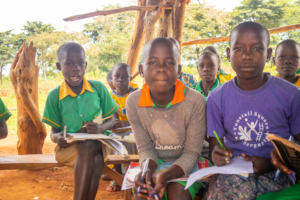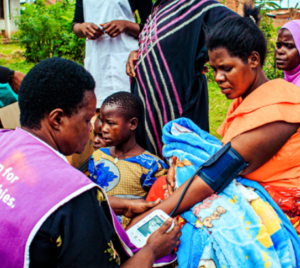Uganda is one of the most climate vulnerable countries and faces huge climate costs annually. However, climate change also presents an opportunity for the country to usher in innovation and transformation and build a more sustainable future and resilient economy.
AUTHORS;

Uganda faces significant economic and productivity losses from climate change. Temperatures have risen by an average of 0.23C per decade since 1950 and are projected to increase from between 1 to 1.5C under the low and medium emissions scenarios respectively. This rise is projected to be as high as between 1.5C to 3C relative to the 1981-2010 average under the high emissions scenario. Similarly, there has been an observed increase in intensity and frequency of extreme climate events in the country
A heavy reliance on climate sensitive sectors makes Uganda’s economy highly vulnerable to climate change. Agriculture, for instance, accounts for 40% of Uganda’s GDP, employs 80% of the country’s labour force and supplies 85% of the exports. However, agriculture in Uganda is mainly rain-fed with only 1% of agricultural production supported by irrigation grossly increasing the vulnerability of the sector to climate variability and change.
Figure 1: Uganda’s agroecological zones
Note: Uganda’s economy is highly dependent on climate sensitive sectors such as agriculture and fisheries. Source: Uganda National Agriculture Adaptation Plan
The IGC partnered with the Ministry of Finance, Planning, and Economic Development to host Uganda’s 7th Economic Growth Forum (EGF). The presenters, Victoria Chemutai (Economist, World Bank) and Samuel Mugume (Assistant Commissioner, Macroeconomic Policy Department, MoFPED) discussed the economic impacts of climate change in Uganda and actions that could be taken to mitigate these.
If no adaptation measures are taken, annual impact costs of climate change are estimated to come up to about US$ 3.2 – 5.9 billion. In 2008 and 2010-11 droughts led to a 3% and 11% depreciation in the value of cash crops respectively. Forecasts suggest that the value of key export crops like coffee are expected to fall by 50% as a result of a contraction in the area suitable for production due to changes in the climatic conditions. This translates to losses of about US$ 1.4 billion by 2050. Accordingly, in her presentation. Victoria Chemutai highlighted the need to gradually transition from these sectors while simultaneously building their short-term resilience.
Water deficits resulting from climate variability are expected to negatively impact agriculture and industry, creating knock-on effects to other sectors. Similarly, climate variability affects the availability of energy from biomass and hydroelectricity generation. Table 1 summarises lower bound and upper bound costs of inaction to climate variability in agriculture, water, energy, and infrastructure in Uganda.
Table 1: Costs of inaction to climate variability in Uganda’s key sectors (USD$ Millions)
Note: The table illustrates the probable costs of inaction to climate variability in agriculture, water, energy, and infrastructure in Uganda for the years 2025, 2050, and the total cost over the period 2010-2050. The table shows that the costs of inaction are expected to increase over time with the lower bound cost of inaction in agriculture is estimated to be US$ 293 million in 2025 and US$ 1,401 million in 2050. The table also shows that the water sector is expected to be the most affected by climate variability, followed by infrastructure and then agriculture. *Loss in the capacity of infrastructure to withstand climate change, UB = lower bound, UP = Upper bound. Source: Government of Uganda (2015)
In both scenarios, the energy and water sectors are anticipated to experience the brunt of the impacts, followed by agriculture and infrastructure encompassing transport and water carrying infrastructure. The repercussions on the water sector are expected to reverberate throughout the economy by impacting the fisheries sector, electricity production, and domestic water consumption and usage.Victoria Chemutai’s presentation highlighted that apart from the direct effects, climate change poses a high financial risk. It has been established that countries that are highly climate vulnerable face a 1.17 percentage point higher cost of public borrowing. Other fiscal risks relate to increased government spending on disaster relief, public expenditure to rebuild and reduced tax revenue due to the lower economic output associated with climate impacts.
A third strand of impacts is illustrated in Chemutai’s presentation which underscored the interconnectedness of Uganda’s production and export capabilities with global policies. Notably, the adoption of mitigation and adaptation policies by Uganda’s trading partners and private companies have implications for what Uganda can produce, how it can be produced, and exported. For example, the implementation of carbon pricing by trading partners necessitates that Uganda shifts to the production of low-carbon goods and services.
Therefore, in the absence of action, climate change will hinder the achievement of Uganda’s 2040 aspirations: achieving upper middle-income status and reducing poverty to 5%. Climate adaptation thus must be central to Uganda’s growth and poverty reduction agenda.
Several steps have already been taken by the country to adapt to the changing times. A green growth strategy was developed to mainstream climate change across government activities. Policy tools such as solar subsidies to incentivise use of cleaner energy have been rolled out and adaptation plans across various sectors have been developed. However, enforcement remains weak, and resources are insufficient.
If fully implemented, strategies laid out in Uganda’s Nationally determined Contributions (NDCs) could have a positive impact on the economy. This was the focus of Mugume’s presentation.
Uganda aims to reduce emissions by 24.7% compared to business as usual (BaU). The NDCs identify some strategies for mitigation and adaptation. These include among others, improving energy efficiency (particularly reduction in transmission and distribution losses), improving renewable energy production, and building climate resilient infrastructure development such as railways and smart agriculture.
Different strategies proposed in the NDCs have been simulated to produce positive economic impacts. Increasing taxes on petroleum and earmarking these for infrastructure development of roads for example, was shown by Samuel Mugume to lead to an increase in GDP. Similarly, modelling the impacts of an expansion in renewable energy showed positive impacts on employment and GDP by about 0.4% per year. Investment in clean energy also has the potential to reduce government expenditure through subsidies provided for fossil fuel-based energy production.
Figure 2: Renewable energy expansion simulation in Uganda using the E3g model (2022 – 2040)
Note: The chart simulates impacts of increases investment in renewable in Uganda. This is expected to positively impact GDP and reduce government consumption expenditure. Source: Samuel Mugume’s presentation, Uganda Economic Growth Forum 2023.
Policy action needed to increase Uganda’s adaptation to climate change
There are other areas of action that could be crucial to adaptation. In addition to the adaptation actions highlighted by Samuel Mugume, Victoria Chemutai’s presentation touched on a number of action areas that could help Uganda adapt to climate change. Firstly, the majority of people that will be affected by climate change are the urban poor and people in rural communities. Uganda is going through rapid urbanisation at a rate of 5.5%. Supporting development planning for urban expansion through key infrastructure investments can help municipalities to reduce the impacts of climate change on households and firms as well as to manage climate-related urban growth. Urban planning can ensure that climate related migrants are well included and integrated into cities, reducing their exposure to vulnerable informal settlements as well as reducing emissions from transport through well planned roads and settlement areas.
In adapting to other countries’ mitigation policies, it is crucial for Uganda to invest in emission tracing infrastructure to demonstrate carbon competitiveness. Chemutai highlighted that policies such as the carbon border adjustment mechanism and the implementation of NDCs by other countries for example will require trading partners to increasingly demonstrate carbon competitiveness. By investing in carbon tracing infrastructure, Uganda can get ahead of the economic implications of these mitigation efforts and policies.
Given the impacts of climate effects on infrastructure, it is important for Uganda to incorporate climate objectives into infrastructure planning. This will bolster infrastructure resilience and prevent the entrenchment of carbon-intensive and polluting investments. In addition, Chemutai stressed the importance of research and development in climate smart technologies to realising these goals and Uganda’s adaptation efforts.
Mobilising financing for climate action
Effectively implementing climate strategies will require substantial resources. Uganda NDC’s estimate that the country requires US$ 28.1 billion to implement adaptation and mitigation needs up to 2030. Public investment alone will not be able to meet this demand. Innovative financing approaches complemented with innovative climate-sensitive policy are therefore important for mobilising resources.
Figure 3: Actual versus future climate finance necessary to maintain 1.5C pathway, globally
Note: The graph shows the global actual and future climate finance necessary to maintain the 1.5 °C pathway from 2011 to 2050. Although actual climate finance has been increasing over time, it is still below the level that is needed to maintain the 1.5 °C pathway. The graph also shows that the gap between the actual and future climate finance is expected to widen in the coming years. Source: Climate Policy Initiative.
Ultimately, more needs to be done to attract private finance. Strengthening climate information, broadening the investor base, adequate pricing of climate risks and expanding the involvement of multilateral development banks and development financial institutions can facilitate the flow of private climate finance. Adequate climate information is crucial for enabling assessment of risks and guiding investment in adaptation and mitigation by financial institutions. Therefore, strengthening the climate information architecture is key for mobilising private finance.
Similarly, understanding of the financial risks related to climate change and climate policies will incentivise investors to allocate funds towards environmentally beneficial investments with lower climate-related financial risks, illustrating the importance of adequately pricing of climate risk.
Fiscal priorities for adapting to climate change
In addition to revenue mobilisation, fiscal policy has an important role to play in climate action. Chemutai focussed on four areas of priority for fiscal policy in climate adaptation in Uganda including use of carbon taxes, green budgeting, and a dedicated climate fund. Carbon taxes were highlighted as a potential source of revenue for climate action in Uganda. In Ghana for example, at a carbon tax rate of US$ 30/tonne, there is revenue potential of close to 0.7% of GDP arising out of 14.7 million tonnes of carbon dioxide equivalent embedded in fossil fuels in 2018. Integrating carbon charges on royalties from oil extraction in Uganda for example, is one way through which carbon taxes can be operationalised in the country and mobilise climate finance.
Along with revenue generation, carbon pricing can facilitate a transition from carbon-intense fuels to cleaner technologies and production methods. This, in turn can encourage the adoption of more climate-friendly fuels and production processes while promoting research and innovation. In contexts with a significant informal sector, like Uganda, recycling carbon tax revenue through reducing labour and production taxes, can incentive the formalisation of informal firms thereby creating fiscal co-benefits.
On the other hand, Chemutai stressed that carbon taxes are also associated with macroeconomic impacts and political risks that need to be considered for an effective roll out. These include reduced investment and employment resulting from higher energy prices and political risk associated with increased energy costs. As such, it is essential to take into account certain key factors to make carbon taxes more politically feasible and economically efficient. These can include:
- Reducing other kinds of taxes to lessen the tax burden.
- Providing targeted assistance for low-income households, trade-dependent industries and vulnerable workers. Redistributing revenues to households in the lower income bracket while simultaneously reducing overall income tax rates can alleviate the tax burden borne as a result of newer carbon taxes.
- Increasing investment in green energy which signals commitment to climate goals making carbon pricing more legitimate.
Green budgeting was another fiscal priority identified by Chemutai. Budgets can help improve the consistency of public revenue and expenditure with climate goals. Identifying and assessing the sustainability and climate impacts of budget items can help government to more closely align budgets with the climate and sustainability objectives, prioritise expenditure on high impact activities, and translate goals like the NDCs into action. Furthermore, green budgeting can facilitate the issuance of green bonds by signalling the commitment of public organisations and institutions to sustainability and climate issues. This is one area that Uganda has not yet fully tapped into. To ensure the success of green budgeting, a comprehensive government approach is necessary. This approach should include clearly defined objectives, roles and responsibilities based on objectives highlighted in the NDCs, along with effective coordination between government departments and line ministries.
In addition to green budgeting, Chemutai argued that a dedicated climate fund can offer multiple benefits. Being country-specific ensures that funds are tailored to the country needs and reduces the risk of mal-investment in climate action. Furthermore, a dedicated fund signals commitment to climate action and facilitates mobilisation and management of international support and resources from other players. This streamlines the processes and in effect improves the speed with which financing can be delivered. Similarly, dedicated climate funds can make climate financing options more accessible especially for smaller actors.
Key steps for climate action in Uganda
Climate change will negatively impact Uganda’s economy and growth trajectory. Uganda will need to adapt to the changing climate but also adapt to other countries’ climate-related trade policies that could impact Uganda’s exports.
The NDCs set out various strategies that can help mitigate emissions and help Uganda adapt to the impacts of climate change. Taking these actions has the potential to positively impact Uganda’s economy.
However, achievement of this impact requires a comprehensive government approach to the actions proposed in the NDCs. Aligning government’s development programmes and strategies such as the Parish Development Model to climate priorities as specified in the NDCs is crucial for the achievement of the whole government approach and for the realisation of climate action itself.
Fiscal policy can play an important role in action. Fiscal tools such as carbon taxes, green budgeting, sustainable procurement practices and a dedicated climate fund can facilitate mobilisation of resources and effective implementation of climate action in Uganda.
Mobilizing adequate financing both domestically and externally is crucial for the climate action that Uganda must take. However, there are key steps that need to be taken to facilitate private investment in climate action. These include, among others, strengthening climate information, adequate pricing of climate risks, expanding the investor base and expanding the involvement of multilateral development banks and development financial institutions.
Credit: Bagombeka Job

























































